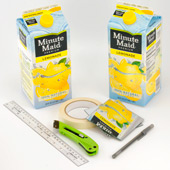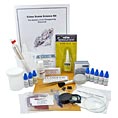While modern spies rely on the latest technological advances, many of the principles of espionage have remained unchanged for hundreds of years. For example, the East German secret police used invisible ink to pass hidden messages during the Cold War, and the decades-old formula was deciphered just a few years ago. Likewise, the CIA only recently released formerly classified documents outlining the various types of invisible ink used during World War I.
Among them is an ink made from one of the same ingredients as our invisible ink project. So don’t think you need a sophisticated GPS (global positioning system) surveillance transmitter to conduct your own spying; submarines still use periscopes today and so can you!
Milk Carton Periscope
The word periscope comes from the Greek roots peri, meaning “around,” and skopos, meaning “to look.”
The instrument is comprised of a tube with two parallel mirrors or prisms positioned facing each other at a 45-degree angle.
Although most often associated with submarines, during World War I, infantry troops used periscopes to see out from the trenches without exposing themselves to enemy fire.
What You Need:

- Two half-gallon milk or juice cartons
- Two 4×4 square mirrors (or other small mirrors)
- Utility knife or box cutter
- masking tape
- pencil or pen
- ruler
What You Do:
(Ask an adult to do the cutting!)
1. Use the box cutter to cut off the peaked spout end of each milk or juice carton.
2. Cut out a window at the bottom of the front of each carton, leaving a half inch on either side of the holes.
3. Turn one carton on its side with the hole you made facing to your right. On the side facing up, measure 2 – 3/4 inches from the top of the left edge and make a mark with your pencil or pen. Use your ruler to draw a diagonal line from your mark to the top right corner. Using a box cutter, cut the line the same length as one edge of your mirror.
4. Repeat step 3 with your other carton.
5. Slide one mirror into the diagonal slit you made. Look through the window. Adjust the mirror until the image is straight, then secure the mirror with tape. Repeat with your other carton.
6. Finally, insert the open end of one carton into the open end of the other with the windows facing away from each other. Secure with tape, and voila! You’re ready for your mission!
What Happened:
We’re able to see objects because electromagnetic energy in the form of light waves bounces off the objects and travels into our eyes, forming an image on the retina that our brains can read.
However, since light travels only in a straight line, if something is not in our direct line of sight, the refracted light bouncing off it cannot enter our eyes.
But periscopes redirect light waves, allowing us to see objects around corners, over obstacles, or, as in a submarine, from underwater. Light bounces off an object and hits the first mirror, then it’s reflected through the tube, off the other mirror and into the eye of the viewer.
Can you think of ways to modify the periscope? How would using a longer tube or a smaller mirror change what you see? Can you use your periscope to see underneath objects, too?
Can you think of other reflective objects you could use in place of the mirrors? How about old CDs or DVDs? What about the tubing? Could you make a periscope out of something besides juice cartons?
| Featured Kit Crime Scene Investigation Kit  Solve the ‘Mystery of the Disappearing Diamonds’ with this crime scene lab kit! Explore the forensic science field and perform seven detailed experiments to uncover which suspect stole the stones. Projects include dusting and fuming for fingerprints, fingerprint analysis, chromatography & ink analysis, blood type analysis (using simulated blood samples), and fiber analysis using a flame test. Ages 12 & up. |
Invisible Inks
Invisible inks, also called sympathetic inks, can be made with many different substances. Sometimes they appear when you heat them up; other times another chemical reveals them. Get creative and see how many kinds of invisible ink you can find.
What You Need:
- Ink type 1 – lemon juice, grapefruit juice, vinegar, milk
- Ink type 2 – saltwater, pencil
- Ink type 3 – phenolphthalein, Windex
- Cotton swabs or paintbrush
What You Do:
1. Use a liquid like lemon juice or milk as ink. Write a message on a piece of white paper using a paintbrush or cotton swab, dipping in the ink frequently. Let the message dry. Turn on the toaster and carefully hold your paper over it. The heat will make your secret writing appear!
2. Dissolve as much salt as you can in 1/4 cup of hot water. Write a message with the saltwater and let it dry. Now rub over the message with pencil lead and watch it appear!
3. Some sympathetic inks work when you apply heat, but others work because of acid-base reactions. Use phenolphthalein solution to write a message on a piece of paper and let it dry. After it is dry, spray it with some Windex. Since Windex is a base, it will turn the phenolphthalein bright pink.
What other sympathetic inks can you find? Which kind shows up best? Which kind lasts longest?
More Spy Science Projects
Science Links
Learn more about light and optics.





